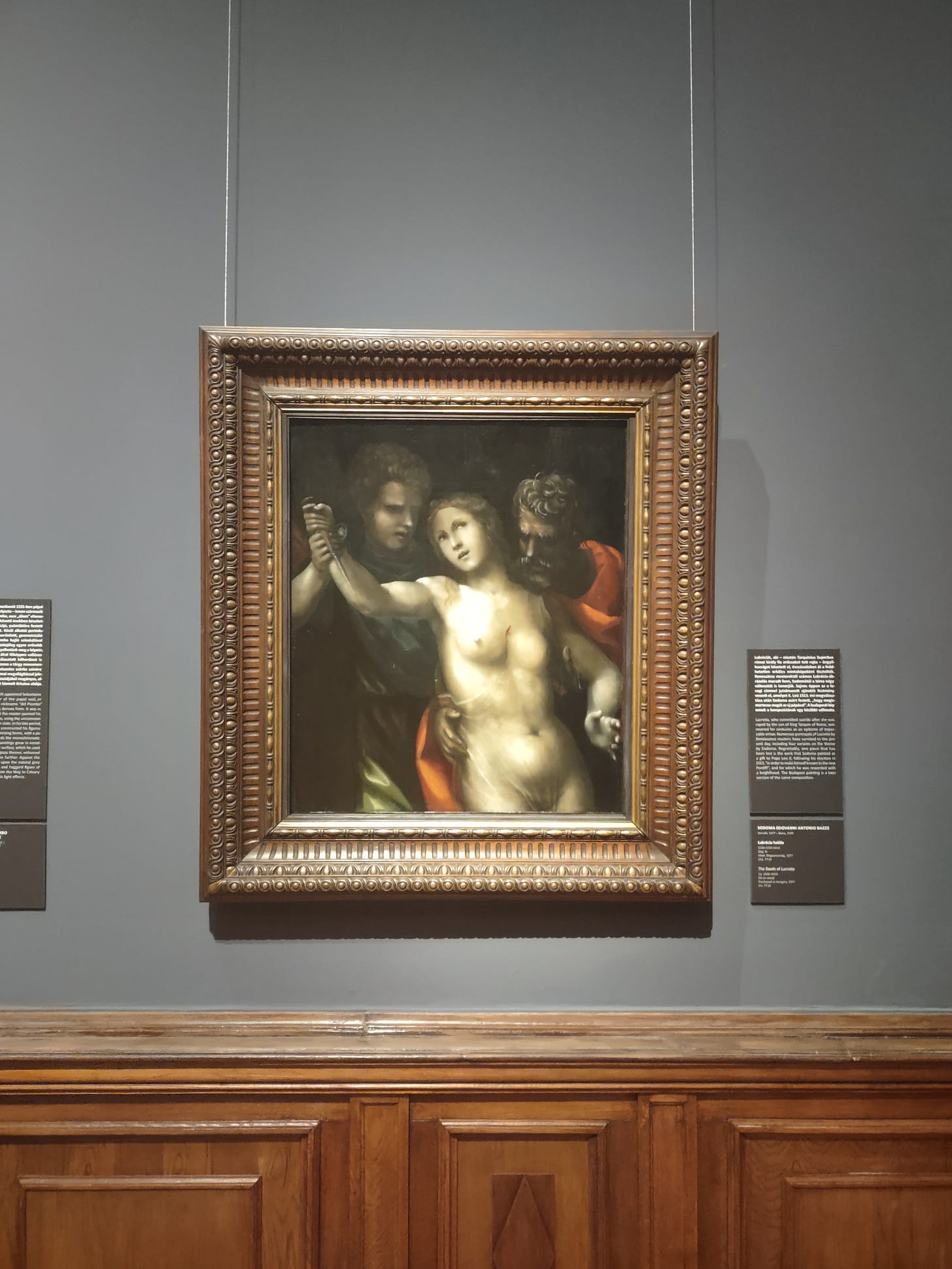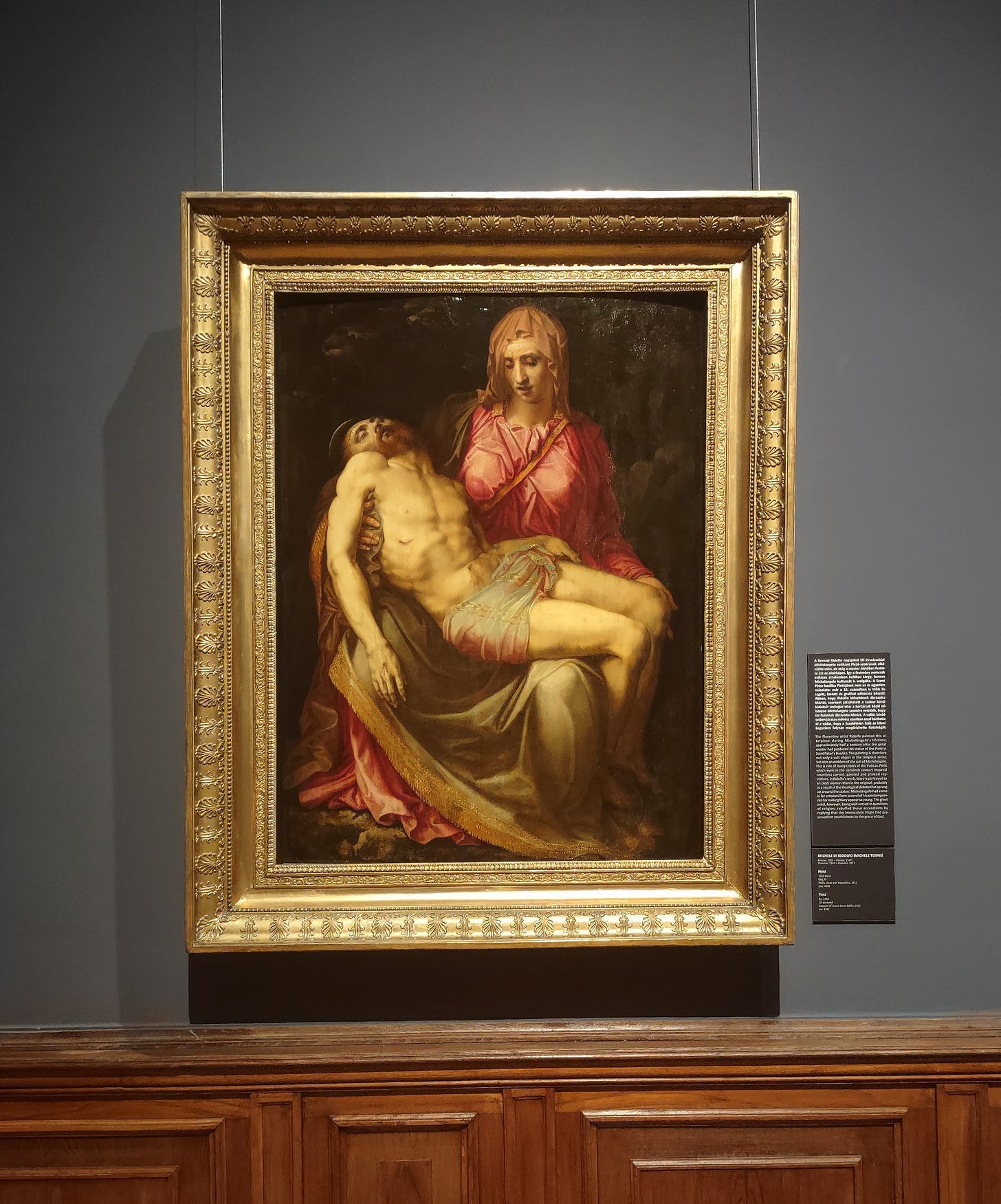Lucretia
Art museums are quiet places full of silence. Visitors walk reverently, pausing now and then to face the faces peering from their frames. The figures look back sometimes, and those are the paintings that I like best, the ones where the people break through the paint and look like they know. In just another moment, a muscle will move—mine or theirs—one of us will draw a gentle breath, but not just yet, just one more moment, one more second, not yet, no.
Two paintings caught my breath that way last week. We were on the top floor of the Budapest Museum of Fine Arts, where the paintings hang directly across from each other all along a long blue gallery. I stopped at the far end.
The painting in the corner on the left is called The Death of Lucretia.

As the legend goes, Lucretia was raped by Tarquin, the son of the last king of Rome. Lucretia loved her husband, so she steadfastly rejected Tarquin’s advances. After the rape, she committed suicide as a kind of self-immolation to right the great wrong that had been done to her. In the picture, she’s calm—naked and beautiful. She’s trapped in the arms of her attacker, but her eyes gaze gently heavenward. Blood trickles down her breast, and there’s a raised knife in her hand.
Directly across from Lucretia, there’s another painting of another woman. Her head is bowed. Grief rests on her shoulders and tears run down her cheeks, but she’s regal and composed. In her arms, she cradles the naked body of her murdered son, the King of the Universe. There’s an open wound over His Heart and blood seeps from it. There hangs Pieta, in her grief and majesty, framed in gold.

Violence doesn’t usually happen silently. As they’re happening, moments of violence last an eternity but the clock doesn’t really stop that way. That’s part of the reason that courage under fire is so admirable. No one really knows their mettle until it’s been tested, and testing fire is fast. It doesn’t last. It burns away chaff.
Artists get the grace of capturing moments—the moments that no one else can see because they last for only a split second or appear only through a kind of second sight that catches time in its tracks, lightning paused in a ghastly, glorious flash. The courageous rebellion, the triumph of the will over a long-fought vice, the virtue that was practiced and is suddenly proven, the crying ache of a heart under the knife.
Lucretia’s moment was mastery, self-possession, and purity arrayed against terror and viciousness. In the years since, she’s been rejected as a symbol of unyielding femininity that’s been held to and racked by an impossible, unrelenting standard—wielded by men to keep women repressed. Much has been lost since Eden. The second half of Eve’s curse has come true: her desire would be for her husband—in jealousies, in spite, and in dissension—and he would rule over her—in lust, in anger, and in bitterness.
Mary’s moment has been rejected too. She cradles her broken Son against the shards and splinters of her broken heart—rejected because He has been rejected likewise. Mary bears the same mark of self-possession, the same mastery and crystalline purity that speaks out of Lucretia’s quiet eyes, but there’s a difference. Christ has entered, suffered, and died, to right Lucretia’s wrong. He let the lusts and horrors of the world kill him so that Lucretia could find consolation when she raised her eyes to Heaven and so that His Mother could be clothed with the sun and the stars of the galaxy.
Christ bared his own body and gave it up to death so that men and women could rediscover Eden and learn the love and honor that existed in the beginning. He reset time. And so Lucretia and Pieta meet across a gallery and make peace across the centuries in the Blood of the Man who did what all good men must strive to do in turn: die to self in a bid to restore the Garden.
There’s a dark side to all of this—a dark side to the second sight that artists exercise. It proves the rule. Flashes of light show up both the peaks and the valleys and choosing what to watch for when the lightning strikes requires virtue and a disposition towards the good. In times that were simpler, when angels and demons were part of common parlance, artists didn’t go down dark roads often. Darkness wasn’t an artistic end because it couldn’t be: it didn’t mean anything in those bygone days to paint an ugly picture and call it what it wasn’t: beautiful, insightful, pure. Those bygone days are gone, but the artist’s instinct isn’t. Artists still look for the fabric of reality and try to capture what they see when the veil tears between what’s here and what’s beyond.
We had occasion recently to happen upon an unfortunate art gallery that houses an unfortunate photograph—art, allegedly. It’s subject: “mold.” The artist’s proclaimed purpose was to capture the reality behind reality in a kind of credo about what it is that holds the world in being. Even at the microscopic level, every tiny organism bears the mark of the Maker but somehow, mysteriously, this picture was just ugly: heavy, disgusting, and harsh.
I thought at first it was the onslaught of “art” that we’d survived up to that point that made the particular picture so distressing. We’d left bright blue October and been frogmarched through gallery after gallery of pseudosexual self-expressive hell. We were surrounded by admiring patrons with quizzical, cultured brows. Distorted non-bodies, half-object, half-motor, part-multi-human, blended in layers of intrigue and “emotional complexity”: how fresh, how new, how daring! School children were getting marched through the gallery too and getting accustomed to disturbia—a thoroughly wretched sight. We were all in dark places, once, before the Crucifixion, so darkness inhabiting an artist’s heart isn’t the problem. The problem is that dark places must be baptized. The old man must be killed before he can be glorified. Darkness is a cruel, deceitful, and hydra-headed master—legion makes the darkness darker.
We’re hybrid creatures, you and I, embodied persons with immortal souls and mortal bodies. Our souls will live forever even as our bodies suffer “the thousand natural shocks / that flesh is heir to” after Eden. It’s not a neutral act, to focus exclusively on the material world, because that focus turns upon a metaphysical turning away from truth, immortality, and the deepest threads of what it means to be a human being. A man gone wrong is a tragedy—not an unsurprising homo sapiens behaving just the way that he’s expected to. Our highs are higher and our lows are lower than the rest of the created order because they span the distance between glory and degradation. And that’s why art that cuts out Heaven ends in Hell.
The triumph is greater than the downfall, though, because good art lasts. Great artists catch at the veil, draw it gently back, and set down a moment, breathless and diamondlike, in a medium that lets us see what they can see: a reckoning with what lies beyond. We each have our own reckoning to do, which is why that which orients our hearts matters so enormously. So here’s to the good, the true, and the beautiful, and a reckoning at the feet of the resurrected King who has restored all things.





